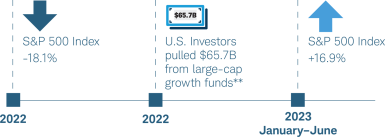Recency bias
- Read transcript
Recency bias—2-minute video
Is the recency bias affecting your clients? Help them find out by sharing this short, client-approved video, which provides actionable insights and guidance on how the recency bias can potentially influence our investment decisions. Then consider exploring the behavioral finance program for advisors linked near the bottom of the page for follow-up tools.
The recency bias in perspective.
Key Takeaways:
- Recency bias can lead investors to put too much emphasis on recent events, potentially leading to short-term decisions that may negatively affect their long-term financial plans.
- For example, some investors may have expected both stocks and bonds to continue selling off in 2023, as they did in 2022.
- Advisors can help clients take a broader view of the markets over time, potentially reducing the negative effects of recency bias.
- Educating clients about this bias now may help them better cope with future periods of market volatility.
What is recency bias?
Recency bias is the tendency to place too much emphasis on experiences that are freshest in your memory—even if they are not the most relevant or reliable. Would you want to go for a long ocean swim after watching Jaws? Probably not, even though the actual risk of being attacked by a shark is infinitesimally small.
In the investing world, recency bias can be hard to avoid. Clients display recency bias when they make decisions based on recent events, expecting that those events will continue into the future. It can lead them to make irrational decisions, such as following a hot investment trend or selling securities during a market downturn.
It can also lead to overconfidence. Consider FAANG, the acronym used to describe Facebook (now Meta), Apple, Amazon, Netflix, and Google (now Alphabet). For years, these five stocks were considered a sure bet by many as they grew faster than both the S&P 500® Index and Nasdaq Composite indices.1 Recency bias might have led an investor to continue holding Netflix, for example, despite widespread revaluation of tech stocks in 2022. That year, Netflix’s stock price dropped more than 50%, and by June 2023, the stock was still down 27% from its all-time high.2
The war in Ukraine serves as another recent example. When Russia invaded Ukraine in February 2022, analysts broadly expected the war to drive up the cost of energy. As a result, the energy sector surged from February 4, 2022, to June 1, 2022. Recency bias might suggest that these returns would continue. However, from June 1, 2022, to August 11, 2023, the energy sector’s returns were well below the broader market.3,4
At a glance: Recency bias
Recency bias is cognitive. It describes the tendency to overemphasize the importance of recent events.
Recency bias in action: After a decade of low inflation, many investors were shocked when the inflation rate rose to 6.4% in 2022. Recent experience may have caused them to discount historical examples of high inflation.
The big problem: The recent past is a poor indicator of the future.
How advisors can help: Advisors can educate investors about how markets move over time.
Past performance is no guarantee of future results. Indexes are unmanaged, do not incur management fees, costs and expenses (or “transaction fees” or other related expenses), and cannot be invested in directly.
* Federal Reserve Bank of St. Louis, Federal Reserve Economic Database (FRED), “Consumer Price Index for All Urban Consumers: All Items in U.S. City Average,” retrieved July 25, 2023.
** Morningstar, Inc., “US Fund Flows: Investors Bail in 2022,” January 17, 2023. URL: https://www.morningstar.com/funds/us-fund-flows-investors-bail-2022.
Why does it matter?
Recency bias can lead clients to deviate from their carefully laid investment plans, which may have damaging long-term consequences.
Consider the cost of chasing hot investment trends: in 2021 real estate was one of the best performing sectors in the S&P 500 Index, delivering an annual return of 46%. A client who subsequently loaded up on real estate stocks may have been disappointed that the sector returned -26% in 2022, eight percentage points lower than the S&P 500 Index that year.5
The takeaway: short-term market moves can potentially sap long-term results, making it more difficult for clients affected by recency bias to reach their financial goals.
What can you do about it?
To combat recency bias, advisors can help their clients take a broader view of how markets tend to move over time and the larger trends that may have the biggest impact on their investment returns. During the rebalancing process, consider illustrating to clients which investments have fared well or poorly, and use that information to initiate a larger discussion about how markets tend to move over time.
It's also important to find ways to curb clients’ impulses to make decisions influenced by recent events. For instance, you might discuss limiting their daily news intake or create a mutually agreed-upon waiting period before making investment decisions. Another strategy: discuss portfolio performance in terms of progress toward a client’s goals rather than focusing on individual return figures.
Working with clients to avoid the effects of recency bias can help keep them from making irrational investment decisions and may help to manage their expectations during the next period of market volatility. In turn, this work will demonstrate the value of your services, potentially leading to greater client trust.
Omar Aguilar, Ph.D.
President, Chief Executive Officer, and Chief Investment Officer
About the author

Omar Aguilar, Ph.D.
What to read next


Decoding client biases
By focusing on education and awareness around behavioral biases, advisors can deliver even more value to clients-and potentially build even stronger practices. Here's how to start.

Biagnostics Toolkit
Biagnostics provides a suite of educational and coaching tools advisors can use to assess client behaviors, build strong relationships and help bridge the gap between clients’ financial wants and needs


